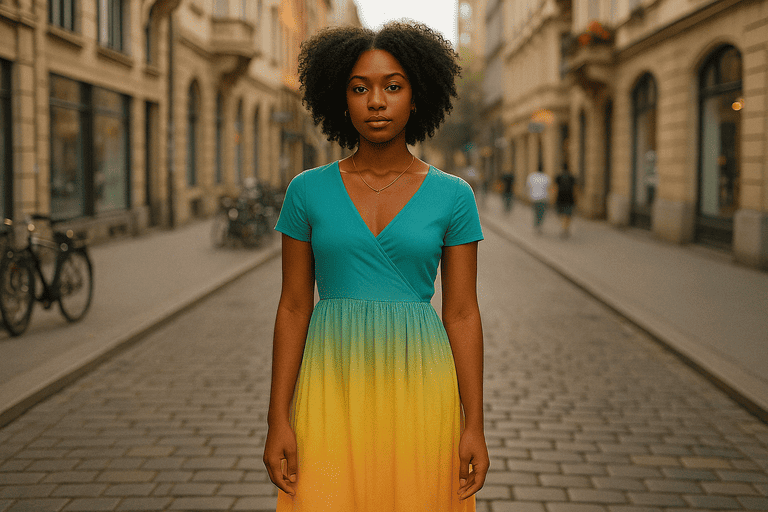Few fashions pieces command attention as effortlessly as the ombre dress. With its gradient color transition and soft blending of hues, this dress style embodies elegance, modernity, and artistic expression. From daytime brunches to sunset weddings, the ombre design offers versatility and visual intrigue that sets it apart from solid-color options.
What makes it even more appealing is the ability to choose from a wide range of shades—pastels, jewel tones, or even bold neons. In addition, fabric choice plays a significant role in enhancing the ombre effect. Light materials like chiffon and satin allow the gradient to flow seamlessly, creating a dreamy, almost ethereal appearance. Whether you prefer a soft romantic look or a vibrant statement piece, there’s an ombre variation for you.
Choosing the Right Ombre Dress for Your Body Type
When selecting an ombre dress, consider how color and silhouette work together to flatter your body shape. For instance, darker hues at the waist and lighter tones near the hem can elongate the legs, while upward gradients can emphasize your shoulders or bust. A-line dresses are universally flattering, but form-fitting options can showcase curves with just as much style.
Ombre Hair Extensions: Transform Your Look Today
In addition, length matters. Maxi ombre dresses offer graceful movement and are perfect for formal occasions, while shorter versions feel fun and flirty for casual outings. Think beyond the traditional; asymmetrical hems, ruffles, or wrap designs add even more dimension to the color flow. Pairing your dress with neutral accessories allows the gradient to shine without competition.
Therefore, knowing your body shape and how ombre shades fall across the fabric helps you select a dress that enhances your natural features.

How to Style an Ombre Dress for Different Occasions
One of the best aspects of the ombre dress is its adaptability. For a daytime event, pair it with espadrilles or simple flats and a straw bag for a laid-back, effortless vibe. In contrast, for evening affairs, switch to heeled sandals, metallic clutches, and statement earrings to elevate the look.
In addition, outerwear plays a key role. A denim jacket makes the look more casual, while a tailored blazer or faux fur shrug adds polish and sophistication. Don’t forget about makeup—subtle shades that echo the dress’s palette create harmony, while a bold lip adds contrast and drama.
Whether you’re attending a beach party or a formal dinner, your ombre dress can adapt beautifully with a few thoughtful styling choices.
Fabric and Texture: Bringing Your Gradient to Life
Understanding fabric and texture is essential when learning how to choose the perfect ombre dress. Fabrics like chiffon, georgette, and organza carry the gradient gently and create movement, enhancing the visual appeal. Meanwhile, silk and satin add a luxe feel that amplifies the richness of deep hues.
For colder seasons, ombre knits and velvets can offer the same color flow with added warmth and comfort. In addition, layering textures—like lace overlays on ombre backgrounds—creates dimension and interest. Avoid overly stiff materials that may break the gradient or restrict flow, as they can diminish the visual softness that makes ombre so captivating.
How to Wear Bandage Skirt for Every Occasion
By choosing the right material, you’re not just wearing a color transition—you’re showcasing wearable art.
The History Behind the Ombre Trend
Although the ombre dress feels fresh and modern, the concept of color gradation in textiles dates back centuries. Traditional dyeing techniques like dip-dye and shibori were used in cultures ranging from Japan to West Africa, each interpreting ombre in a unique way. In the fashion industry, ombre gained mainstream attention in the early 2000s but has evolved to become a timeless element in both casual and couture design.
In addition, technological advances in fabric dyeing have made ombre more accessible than ever. Designers can now create intricate color fades with precision, allowing the gradient to match the movement and shape of a garment perfectly. The trend continues to thrive because of its ability to combine visual complexity with simple silhouettes.
Therefore, wearing an ombre dress connects modern fashion with deep cultural roots and artistic innovation.

Accessorizing Your Look the Right Way
An ombre dress often serves as a statement piece, so accessories should complement rather than compete. Stick to minimalist jewelry—delicate chains, studs, or sleek cuffs—that won’t overpower the flowing gradient. Neutral-colored shoes such as nude, tan, or metallic tones keep the focus on the dress itself.
In addition, consider the style of the dress when choosing your bag. A soft clutch works well with formal designs, while a slouchy tote adds balance to casual styles. If your ombre dress features bold hues, coordinate your accessories with the lightest or darkest shade to maintain harmony. For a more daring look, select one accent color from the gradient and echo it subtly through your accessories.
When styling is intentional yet understated, your ombre dress truly gets the spotlight it deserves.
Seasonal Styling: Wearing Ombre Year-Round
While often associated with spring and summer, the ombre dress can easily transition into all seasons with the right styling. In warmer months, sleeveless or off-the-shoulder versions in pastel gradients pair beautifully with sandals and light accessories. During fall, layer your dress with a leather jacket or longline cardigan in one of the dress’s hues.
In addition, winter styling calls for deeper tones—think burgundy fading into navy or emerald into black—paired with tights and ankle boots. Scarves in matching colors enhance warmth without disrupting the ombre flow. Don’t shy away from wool or velvet ombre pieces; they’re perfect for cooler days while maintaining visual interest.
How to Wear a Shawl with a Formal Dress Elegantly
Therefore, with thoughtful layering and palette adjustments, ombre remains stylish and wearable year-round.
Ombre Dresses for Special Events
Looking for the perfect outfit for weddings, galas, or upscale parties? The ombre dress delivers a sophisticated yet modern appearance suitable for any formal occasion. Opt for full-length gowns with subtle transitions in color for elegance that doesn’t scream for attention. Pair them with heels and understated accessories to maintain the focus on the dress.
For bridesmaids, ombre designs offer a cohesive yet unique look—everyone wears the same style but in slightly varied shades of the gradient. This approach is especially striking in photos and complements a variety of skin tones. In addition, cocktail-length ombre dresses with metallic finishes add sparkle to semi-formal events without going over the top.
When it comes to making a memorable entrance, ombre gives you both impact and grace in one seamless blend.
Caring for Your Ombre Dress
Because of the dyeing process, ombre garments often require extra care. Always check the care label, but generally, it’s best to hand-wash or use a gentle cycle with cold water. Avoid harsh detergents that could disrupt the color fade. Instead, use color-safe or delicate formulas to help preserve vibrancy.
Hang the dress to dry in a shaded area to avoid sun damage, especially if the gradient includes pastel tones. In addition, store your dress away from direct light and in a breathable garment bag if possible. These small efforts ensure that your favorite ombre dress maintains its beauty for many seasons to come.
Taking proper care not only extends the life of the fabric but also ensures your investment stays photo-ready every time you wear it.

Quick Recap
Let’s revisit everything we’ve covered in this ultimate guide to styling and choosing the perfect ombre dress.
We started with why ombre dresses have remained timeless—thanks to their striking gradient effect and adaptable nature. You learned how to select the best ombre dress for your body type and how different silhouettes and lengths play a role in highlighting your shape. From casual outings to elegant events, we covered how to accessorize, what fabrics to choose, and even touched on the rich cultural history behind the ombre trend.
Next, we explored how to wear ombre across all seasons, with tips for layering and color palettes. You saw how to style for special occasions and how to care for your dress so it stays beautiful over time.
In the end, the ombre dress is not just a trend—it’s a staple of expressive fashion. With the right styling, you can wear it confidently, creatively, and season after season.

